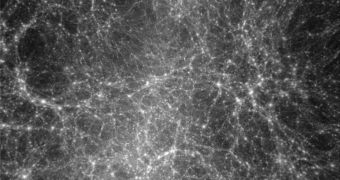Astrophysicists from the Nagoya University and the University of Tokyo Institute for the Physics and Mathematics of the Universe (IPMU) have determined that dark matter is literally everywhere around us, creating a huge web of matter that encompasses everything we can see.
While the new study does not provide any additional insights into the nature of dark matter itself, it does provide some insight into how it is arranged throughout the Universe. Scientists are hopeful that the new data will aid them in their quest to understand this elusive form of matter.
Apparently, dark matter halos are not only found at the core and boundaries of galaxies, or inside clusters and superclusters, but also in the intergalactic space, as well as huge open areas separating large agglomerations of baryonic matter, called cosmic voids.
What makes this stuff so hard to study is that it does not interact readily with anything, not even its own self. Light passes through it largely unaffected, and baryonic (regular) matter experiences the presence of dark matter only through the force of gravity.
Based on previous studies, it is now widely accepted that dark matter makes up about 22 percent of the matter-energy budget of the entire Universe. Normal matter accounts for only 4.5 percent of this total, while the remainder is accounted for by another unknown quantity, called dark energy.
The Japanese research group, led by expert Shogo Masaki, conducted the study by compiling a series of computer models. These simulations included complex datasets covering 24 million galaxies, their distribution, and their interactions, Space reports.
They focused their attention on gravitational lensing, a process through which the characteristics and path of light coming in from distant galaxies are changed as they move through strong gravitational fields. By backtracking the paths light traveled, they were able to find the dark matter that bent it.
What the group discovered was that dark matter originating in a galaxy in fact extends halfway through intergalactic space, until it fully overlaps with similar dark matter extensions from neighboring galaxies. The web formed via this process encompasses the entire Cosmos.
Details of the investigation were published in the February 10 online issue of the Astrophysical Journal.
The most intriguing implication this study has is that galaxies only appear separate if we take normal matter into account. Once dark matter is factored in, all galaxies are in fact connected through this mesh.
What this implies further is that the visible agglomerations of stars we call galaxies are in fact just peaks (areas of high mass concentration) in a sea of continuous matter spanning the entire Universe.

 14 DAY TRIAL //
14 DAY TRIAL //